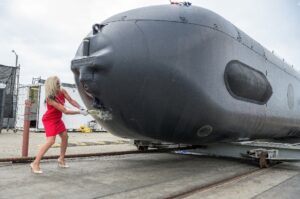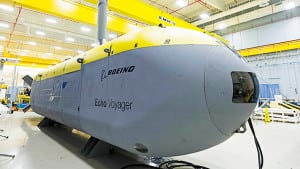Navy officials this week confirmed the service will enact the Government Accountability Office’s (GAO) recommendations as it moves forward with the Orca Extra Large Unmanned Undersea Vehicle (XLUUV) while noting it is a challenging vehicle.
The XLUUV program is procuring five 54-inch vehicles based on the Boeing [BA] Echo Voyager vehicle to support mine countermeasures, anti-submarine warfare and intelligence, surveillance and reconnaissance (ISR) missions.

“Orca is an over 80-foot long UUV with a modular payload bay and with mining as its intended first mission set,” Rear Adm. Casey Moton, program executive officer for Unmanned and Small Combatants, said during the annual Naval Submarine League symposium on November 2.
A September GAO report found the XLUUV program is at least three years late and 64 percent more expensive than planned due to the Navy not developing an executable business plan or business case to ensure the vehicles could be delivered on the timeline. It also found these issues were partially caused by the Navy’s decision to not require the contractor to demonstrate its readiness to fabricate the XLUUVs in the Navy’s configuration, leading to later revisions and alterations (Defense Daily, Sept. 29).
The GAO said schedule delays grew as no production readiness review was implemented to account for major differences between the Echo Voyager and XLUUV. Changes between the two designs include major battery differences that led to the need for a new battery design and battery subcontractor for the vehicle, along with several other structural and construction changes.
Moton acknowledged the program’s challenges described in the GAO report along with general pandemic production issues and admitted “there are certainly lessons learned by both Boeing and the Navy.”
“The program has experienced many of the same issues impacting American industry during and post pandemic: production and engineering resource challenges, shortages of critical parts and forgings and supply chain factors including in the production of the batteries,” Moton added.
He said a program of record acquisition for Orca will follow after the Navy fields the first five prototypes.
Moton confirmed the service will enact the GAO’s recommendations to gain more confidence in cost and schedule of the vehicles in the future as well as conducting a production readiness review.
“We would certainly do that on both of those and the Navy concurred with those recommendations.,” he said. “Before we move into the program of record, we will absolutely ensure that we do a rigorous Production Readiness Review as we do for all of our production programs. And we will absolutely ensure that we have a good understanding of cost and schedule.”
Moton said he thinks the Orca program will ultimately be more informed than typical programs due to the five prototype vehicles.
“By doing the prototypes and with the earlier prototype, in Boeing’s case Echo Voyager, we’ll actually be more informed than typical programs might be when they proceed. So I think we’re going to take all that on board and move out.”
Moton also said despite development and production issues related to the pandemic and also described in the GAO report, the team is close to full integration. The Boeing team is expected to test and deliver the Orca test vehicle, dubbed the XLE0, in early 2023.
“These prototypes are complex machines, an unmanned diesel electric underwater vehicle with lithium ion batteries, the payload bay I mentioned and variable ballast systems to enable operation – all enabled by more advanced autonomy and communications.”
Moton would not disclose the post-prototype Orca timeline because it is being worked through in the fiscal year 2024 budget process.

“I’m not going to get into any specifics on what the timing is. But it’s certainly informed by what our experience has been with the prototypes, but also informed by the necessity and the mission and the potential missions.”
Earlier in the symposium on Nov. 1, Rear Adm. Doug Perry, director of Undersea Warfare (N97), said the Navy expects the test article to be delivered in 2023 and noted the vehicle is designed to carry a payload of clandestine-delivered mines “with modularity in the future to carry a variety of payloads.”
Vice Adm. Bill Houston, commander of submarine force, U.S. Atlantic Fleet Commander, and Allied Submarine Command, told reporters he compares the XLUUV to a bus that can drive independently and operate in inhospitable areas.
“Going through the water, it’s a very dense medium, you can’t communicate, power density is very challenging. I basically equate it to just doing a medium UUV that is trying to go to the moon. Doing an XLUUV is equivalent of trying to go to Mars, it’s very, very difficult.”
However, Houston said the XLUUV is critical “because it makes up in some cases for a lack of submarines and numbers. It gives you a capability that you will not have because of just the pure numbers of submarines. So it gives you additional capacity that you don’t have because you have a limited number of SSNs.”